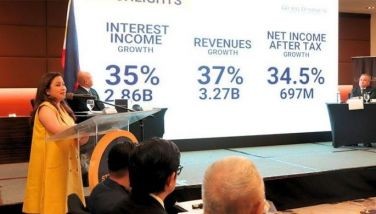Wrong complaint

September 30, 2003 | 12:00am
Can a notice of lis pendens be annotated on the title to a property because of the pendency of a collection suit for nonpayment of construction services and materials used for the construction done on said property plus unrealized income, damages and attorney’s fees? This is the issue raised in this case of AEI.
By virtue of a Construction Contract, AEI undertook the construction of the four townhouses and one single detached unit for HCR. Due to some misunderstanding during the implementation of the contract, AEI filed a suit against HCR before the Regional Trial Court for sum of money with damages more specifically P 4,854,299.94 for unpaid construction services; P1,595,551 for construction materials and tools held by HCR; P2,250,000 for loss of expected income; P800,000 by way of rental of equipments held by HCR; P5,000,000 for moral damages; and attorney’s fees consisting of 25 percent of the total claim, P200,000 acceptance fee and P2,500 appearance fee.
On the same day AEI filed a notice of lis pendens for annotation of the pendency of said civil case on the titles to the lots where the construction was done. Later on however, the RTC dismissed the complaint of AEI for failure to comply with a condition precedent to the filing of a court action which is the prior resort to arbitration. While the RTC initially ordered the cancellation of the notices of lis pendens on the titles, it subsequently reinstated said notices of lis pendens because, according to the RTC, AEI appealed from the order of dismissal thus making the case still pending. The RTC ruled that a notice of lis pendens serves only as a precautionary measure or warning to prospective buyers of a property that there is a pending litigation involving the same.
The CA however reversed the RTC. It ruled that the re-annotation was without legal basis because the registration of such notices is allowed only when the court proceedings directly affect the title to, or the use or the occupation of, the land or any building thereon. According to the CA, the complaint of AEI was purely intended to collect a sum of money and to recover damages.
AEI questioned this ruling of the CA before the Supreme Court. It contended that the money claim of AEI on the cost of labor and materials for the townhouses constructed on HRC’s land is a proper contractor’s lien under Art. 2242 of the Civil Code that justifies the annotation of the lis pendens on the land titles.
Was AEI correct?
No.
Based on the Complaint and the reliefs it seeks, no such lien or interest over the property was ever alleged. Verily it was purely a personal action and a simple collection case. It did not contain any material averment of any enforceable right, interest or lien in connection with the subject property.
Even assuming that AEI had sufficiently alleged such lien or encumbrance in its complaint, the annotation of the lis pendens would still be unjustified because a complaint for collection and damages is not the proper mode for the enforcement of a contractor’s lien.
Article 2242 finds application when there is a concurrence of credits, i.e., when the same property of the debtor is subjected to the claims of several creditors and the value of such property of the debtor is insufficient to pay in full all the credits so that there is a need to determine which of the creditors will be paid ahead of the others. This statutory lien should then only be enforced in the context of some kind of a proceeding where all the claims of the preferred creditors may be bindingly adjudicated, such as insolvency proceedings.
In this case nowhere in the complaint does it show that HRC’s properties were subject to the claims of other creditors or was insufficient to pay for all concurring debts. Moreover the complaint did not pertain to insolvency proceedings or to any other action in which the adjudication of claims of preferred creditors could be ascertained (Atlantic Erectors Inc. vs. Herbal Cove Realty Corp., G.R. 148568, March 20 2003).
E-mail: josesison@edsamail.com.ph
By virtue of a Construction Contract, AEI undertook the construction of the four townhouses and one single detached unit for HCR. Due to some misunderstanding during the implementation of the contract, AEI filed a suit against HCR before the Regional Trial Court for sum of money with damages more specifically P 4,854,299.94 for unpaid construction services; P1,595,551 for construction materials and tools held by HCR; P2,250,000 for loss of expected income; P800,000 by way of rental of equipments held by HCR; P5,000,000 for moral damages; and attorney’s fees consisting of 25 percent of the total claim, P200,000 acceptance fee and P2,500 appearance fee.
On the same day AEI filed a notice of lis pendens for annotation of the pendency of said civil case on the titles to the lots where the construction was done. Later on however, the RTC dismissed the complaint of AEI for failure to comply with a condition precedent to the filing of a court action which is the prior resort to arbitration. While the RTC initially ordered the cancellation of the notices of lis pendens on the titles, it subsequently reinstated said notices of lis pendens because, according to the RTC, AEI appealed from the order of dismissal thus making the case still pending. The RTC ruled that a notice of lis pendens serves only as a precautionary measure or warning to prospective buyers of a property that there is a pending litigation involving the same.
The CA however reversed the RTC. It ruled that the re-annotation was without legal basis because the registration of such notices is allowed only when the court proceedings directly affect the title to, or the use or the occupation of, the land or any building thereon. According to the CA, the complaint of AEI was purely intended to collect a sum of money and to recover damages.
AEI questioned this ruling of the CA before the Supreme Court. It contended that the money claim of AEI on the cost of labor and materials for the townhouses constructed on HRC’s land is a proper contractor’s lien under Art. 2242 of the Civil Code that justifies the annotation of the lis pendens on the land titles.
Was AEI correct?
No.
Based on the Complaint and the reliefs it seeks, no such lien or interest over the property was ever alleged. Verily it was purely a personal action and a simple collection case. It did not contain any material averment of any enforceable right, interest or lien in connection with the subject property.
Even assuming that AEI had sufficiently alleged such lien or encumbrance in its complaint, the annotation of the lis pendens would still be unjustified because a complaint for collection and damages is not the proper mode for the enforcement of a contractor’s lien.
Article 2242 finds application when there is a concurrence of credits, i.e., when the same property of the debtor is subjected to the claims of several creditors and the value of such property of the debtor is insufficient to pay in full all the credits so that there is a need to determine which of the creditors will be paid ahead of the others. This statutory lien should then only be enforced in the context of some kind of a proceeding where all the claims of the preferred creditors may be bindingly adjudicated, such as insolvency proceedings.
In this case nowhere in the complaint does it show that HRC’s properties were subject to the claims of other creditors or was insufficient to pay for all concurring debts. Moreover the complaint did not pertain to insolvency proceedings or to any other action in which the adjudication of claims of preferred creditors could be ascertained (Atlantic Erectors Inc. vs. Herbal Cove Realty Corp., G.R. 148568, March 20 2003).
BrandSpace Articles
<
>
- Latest
- Trending
Trending
Latest

























